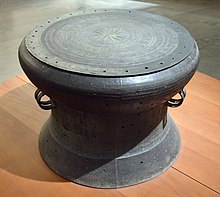
Back حضارة دونغ سون Arabic Donqşon mədəniyyəti Azerbaijani Донгсънска култура Bulgarian Cultura Đông Sơn Catalan Kultura Dong Son Czech Dong-Son-Kultur German Cultura dong son Spanish Đông Sơnin pronssikulttuuri Finnish Culture Dong Son French Kebudayaan Dongson ID
| Part of a series on |
| Prehistoric and ancient cultures of Vietnam |
|---|
| Paleolithic |
| Sơn Vi culture (20,000–12,000 BC) |
| Mesolithic |
| Hoabinhian (12,000–10,000 BC) |
| Neolithic |
|
| Bronze Age |
|
| Iron Age |
|


The Dong Son culture or the Lạc Việt culture (named for modern village Đông Sơn, a village in Thanh Hóa, Vietnam) was a Bronze Age culture in ancient Vietnam centred at the Red River Valley of northern Vietnam from 1000 BC until the first century AD.[1]: 207 Vietnamese historians attribute the culture to the states of Văn Lang and Âu Lạc. Its influence spread to other parts of Southeast Asia, including Maritime Southeast Asia, from about 1000 BC to 1 BC.[2][3][4]
The Dong Son people were skilled at cultivating rice, keeping water buffalos and pigs, fishing and sailing in long dugout canoes. They also were skilled bronze casters, which is evidenced by the Dong Son drum found widely throughout northern Vietnam and Guangxi in China.[5]
To the south of the Dong Son culture was the Sa Huỳnh culture of the proto-Chams.
- ^ Higham, C., 2014, Early Mainland Southeast Asia, Bangkok: River Books Co., Ltd., ISBN 9786167339443
- ^ Vietnam Tours Archived 2013-04-26 at the Wayback Machine
- ^ Nola Cooke, Tana Li, James Anderson - The Tongking Gulf Through History - Page 46 2011 -"Nishimura actually suggested the Đông Sơn phase belonged in the late metal age, and some other Japanese scholars argued that, contrary to the conventional belief that the Han invasion ended Đông Sơn culture, Đông Sơn artifacts, ..."
- ^ Vietnam Fine Arts Museum 2000 "... the bronze cylindrical jars, drums, Weapons and tools which were sophistically carved and belonged to the World famous Đông Sơn culture dating from thousands of years; the Sculptures in the round, the ornamental architectural Sculptures...."
- ^ SOLHEIM, WILHELM G. (1988). "A Brief History of the Dongson Concept". Asian Perspectives. 28 (1): 23–30. ISSN 0066-8435. JSTOR 42928186.
© MMXXIII Rich X Search. We shall prevail. All rights reserved. Rich X Search